At Washington Leadership Academy, computer science is more than punching 0s and 1s onto a keyboard. It’s about logic, language, creativity, entrepreneurship, and equity.
“Regardless of what fields our students decide to go pursue, foundational knowledge in computer science will give them essential skills and help them get hired,” said Natalie Gould, the school’s director of operations.
“If this gives our students a leg up, gives them an edge, I am happy to give it to them.”
Washington Leadership Academy, in Washington, D.C.’s Northeast area, is an XQ School that serves primarily low-income African-American students, a demographic group that has been significantly underrepresented in the technology sector.
Opening Doors to College and Career Success
Nationwide, African Americans made up only about 8 percent of workers in math and computer occupations in 2016, even though they comprise more than 13 percent of the overall population, according to the Brookings Institute.
Part of the reason for this imbalance is that African-American students are less likely to attend schools with strong math and technology programs, and less likely to be pushed toward careers in those fields, according to the Education Trust.
The founders of Washington Leadership Academy wanted to change that. Stacy Kane, the school’s executive director and co-founder, had served as deputy director of Presidential Innovation Fellows under President Obama, a program which recruits the nation’s top tech innovators to solve problems for the federal government.
She and other school leaders wanted to provide rigorous and sophisticated tech courses for students who might otherwise not have those opportunities, opening doors to college and career success. The tech industry offers some of the country’s highest-paid jobs.
Tech, in Real-Time
“We’re going to have (students) tapped into the technologies as they are coming out in real-time rather than having them be 20 years behind,” Kane said in the school’s XQ application.
Students at Washington Leadership Academy take four years of computer science, which includes a survey course, Advanced Placement Computer Science Principles, computational art, and advanced computer science. They can also take elective classes in virtual reality and robotics, and intern at local tech firms.
Students have started their own businesses, designed websites, and solved complex coding problems. One year, the ninth graders designed a school registration website for the next year’s crop of freshmen. A girl in 11th grade recently designed a flower pattern through code and uploaded it to a pair of shoes she could wear. Ten percent have started their own web development businesses and even have external clients.
Seeing Results
The school is only three years old, but it’s already seeing results. Last year all of its 10th graders took the AP Computer Science Principles exam, tripling the number of African American students taking the exam in all of Washington, D.C.
Jordan Budisantoso teaches computational art, creating a new curriculum that merges two seemingly disparate subjects. Most colleges as well as D.C. Public Schools require art in high school, and the challenge has been how to offer art courses while still leaving room in students’ schedules for computer science.
Budisantoso has found a solution. In his course, students learn how to program a computer to create colors, shapes, and patterns to form their own artistic compositions. In a melding of right- and left-brain skills, students use sine waves, coordinate planes and pixels like Van Gogh used a paintbrush.
A New Way of Thinking
“The computer is a tool like any other tool,” he said. But at the end of the day, it’s a new way of thinking. If half your screen is blue and you want to make the other half red, you have to engage in some problem solving. There’s still math involved, but there’s room to be extremely creative. It’s a great way to reach kids in a different way, especially if they haven’t succeeded in math or computer science before.”
The school has other unique characteristics, such as small classes and an emphasis on social justice and civics education, but it’s the computer science program that shines. During a recent visit to Budisantoso’s class, students seemed genuinely enthusiastic about what they were learning and creating.
“It’s about equity,” Budisantoso said. “You’re providing an opportunity for kids who’ve been marginalized to have a voice in that space, to tell their own stories and solve problems their community cares about. ? I believe that if you have an idea and a computer, you can change the world.”
TAGS:



 Tweet
Tweet 



